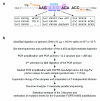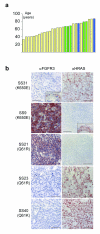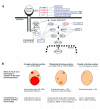Activating mutations in FGFR3 and HRAS reveal a shared genetic origin for congenital disorders and testicular tumors
- PMID: 19855393
- PMCID: PMC2817493
- DOI: 10.1038/ng.470
Activating mutations in FGFR3 and HRAS reveal a shared genetic origin for congenital disorders and testicular tumors
Abstract
Genes mutated in congenital malformation syndromes are frequently implicated in oncogenesis, but the causative germline and somatic mutations occur in separate cells at different times of an organism's life. Here we unify these processes to a single cellular event for mutations arising in male germ cells that show a paternal age effect. Screening of 30 spermatocytic seminomas for oncogenic mutations in 17 genes identified 2 mutations in FGFR3 (both 1948A>G, encoding K650E, which causes thanatophoric dysplasia in the germline) and 5 mutations in HRAS. Massively parallel sequencing of sperm DNA showed that levels of the FGFR3 mutation increase with paternal age and that the mutation spectrum at the Lys650 codon is similar to that observed in bladder cancer. Most spermatocytic seminomas show increased immunoreactivity for FGFR3 and/or HRAS. We propose that paternal age-effect mutations activate a common 'selfish' pathway supporting proliferation in the testis, leading to diverse phenotypes in the next generation including fetal lethality, congenital syndromes and cancer predisposition.
Figures




Similar articles
-
Paternal age effect mutations and selfish spermatogonial selection: causes and consequences for human disease.Am J Hum Genet. 2012 Feb 10;90(2):175-200. doi: 10.1016/j.ajhg.2011.12.017. Am J Hum Genet. 2012. PMID: 22325359 Free PMC article. Review.
-
Contributions of intrinsic mutation rate and selfish selection to levels of de novo HRAS mutations in the paternal germline.Proc Natl Acad Sci U S A. 2013 Dec 10;110(50):20152-7. doi: 10.1073/pnas.1311381110. Epub 2013 Nov 20. Proc Natl Acad Sci U S A. 2013. PMID: 24259709 Free PMC article.
-
Whole-genome sequencing of spermatocytic tumors provides insights into the mutational processes operating in the male germline.PLoS One. 2017 May 22;12(5):e0178169. doi: 10.1371/journal.pone.0178169. eCollection 2017. PLoS One. 2017. PMID: 28542371 Free PMC article.
-
Incidence of fibroblast growth factor receptor 3 gene (FGFR3) A248C, S249C, G372C, and T375C mutations in bladder cancer.Genet Mol Res. 2011 Jan 18;10(1):86-95. doi: 10.4238/vol10-1gmr923. Genet Mol Res. 2011. PMID: 21264819
-
Cellular evidence for selfish spermatogonial selection in aged human testes.Andrology. 2014 May;2(3):304-14. doi: 10.1111/j.2047-2927.2013.00175.x. Epub 2013 Dec 19. Andrology. 2014. PMID: 24357637 Review.
Cited by
-
Germline Stem Cell Competition, Mutation Hot Spots, Genetic Disorders, and Older Fathers.Annu Rev Genomics Hum Genet. 2016 Aug 31;17:219-43. doi: 10.1146/annurev-genom-083115-022656. Epub 2016 Apr 8. Annu Rev Genomics Hum Genet. 2016. PMID: 27070266 Free PMC article. Review.
-
'Sifting the significance from the data' - the impact of high-throughput genomic technologies on human genetics and health care.Hum Genomics. 2012 Aug 2;6(1):11. doi: 10.1186/1479-7364-6-11. Hum Genomics. 2012. PMID: 23244462 Free PMC article.
-
A novel FGFR3-binding peptide inhibits FGFR3 signaling and reverses the lethal phenotype of mice mimicking human thanatophoric dysplasia.Hum Mol Genet. 2012 Dec 15;21(26):5443-55. doi: 10.1093/hmg/dds390. Epub 2012 Sep 26. Hum Mol Genet. 2012. PMID: 23014564 Free PMC article.
-
Fibroblast growth factor signalling: from development to cancer.Nat Rev Cancer. 2010 Feb;10(2):116-29. doi: 10.1038/nrc2780. Nat Rev Cancer. 2010. PMID: 20094046 Review.
-
Discovery of an unusually high number of de novo mutations in sperm of older men using duplex sequencing.Genome Res. 2022 Mar;32(3):499-511. doi: 10.1101/gr.275695.121. Epub 2022 Feb 24. Genome Res. 2022. PMID: 35210354 Free PMC article.
References
-
- Schubbert S, Shannon K, Bollag G. Hyperactive Ras in developmental disorders and cancer. Nat. Rev. Cancer. 2007;7:295–308. - PubMed
-
- Crow JF. Age and sex effects on human mutation rates: an old problem with new complexities. J. Radiat. Res. 2006;47(Suppl):B75–B82. - PubMed
-
- Eble JN. Spermatocytic seminoma. Hum. Pathol. 1994;25:1035–1042. - PubMed
-
- Rajpert-De Meyts E, et al. The immunohistochemical expression pattern of Chk2, p53, p19INK4d, MAGE-A4 and other selected antigens provides new evidence for the premeiotic origin of spermatocytic seminoma. Histopathology. 2003;42:217–226. - PubMed
Publication types
MeSH terms
Substances
Grants and funding
LinkOut - more resources
Full Text Sources
Other Literature Sources
Medical
Molecular Biology Databases
Research Materials
Miscellaneous

